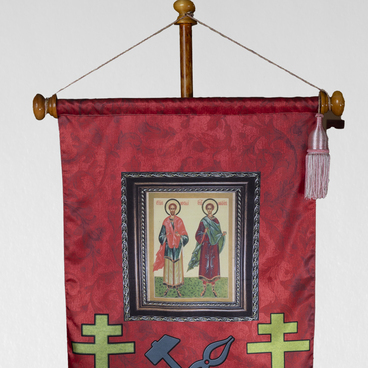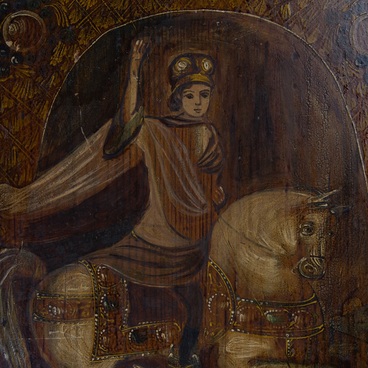The icon of Our Lady of the Sign depicts the Mother of God in the Orant (translated as “one who is praying”) position. On such icons, the Virgin was depicted half-length, and less often in full length. Her palms are raised to shoulder level in a prayer gesture. The name Orant was given to such icons because people believed that the Mother of God prays for the salvation of the world. In the roundel on her chest, there usually was depicted the image of Savior Emmanuel, the other name of the holy infant Jesus Christ. On rarer icons, the translucent image of the Infant is depicted outside the roundel. This technique symbolized the news of Christ’s birth. Hence, this iconography has the second name, better known among Russians as “The Sign”. The Orant was first found in the Catacombs of Rome and was dated to the 5th century AD. Then similar icons were created in Byzantium.
In Russia, one of the first similar images appeared in the 11th century. A full-length mosaic image of Orant was part of the altar of St. Sophia Cathedral in Kyiv. The image is also known as “Unbreakable Wall”: for nearly 800 years, the mosaic wall had never been destroyed unlike the rest part of the cathedral.
Icon painting in Pogar has existed since ancient times. In the 17th century, the Pogar icon-painters’ craft union was in repute in Little Russia, Great Russia, and in the Belarus lands. At different times, the craft union had up to 50 craftsmen and their students called “uchny”. Starodub-Seversky painting school was established in the town of Pogar. It was influenced by the Little Russia, Great Russia, and Belarus cultures, as this region is located on the border of those three territories. Yellow general background, green leaves, and large flowers in the upper right and left corners are attributed to the local icon-painters works.
Two boards panel made up grounds for such an icon. On the reverse side, the boards were reinforced with dowels or wedges that looked like a dovetail. Such a design protected the panel from deformation over time.
Pavoloka, a “liquid” low-count fabric was usually attached to the boards, and then covered with “levkas” (gesso) — a special layer based on chalk. After that, they were primed and painted. The icon painters used natural pigments paint and emulsions-based paint such as an egg yolk. Since the 19th century, icon painters have used oil paint. This icon was also painted in oil.
In Russia, one of the first similar images appeared in the 11th century. A full-length mosaic image of Orant was part of the altar of St. Sophia Cathedral in Kyiv. The image is also known as “Unbreakable Wall”: for nearly 800 years, the mosaic wall had never been destroyed unlike the rest part of the cathedral.
Icon painting in Pogar has existed since ancient times. In the 17th century, the Pogar icon-painters’ craft union was in repute in Little Russia, Great Russia, and in the Belarus lands. At different times, the craft union had up to 50 craftsmen and their students called “uchny”. Starodub-Seversky painting school was established in the town of Pogar. It was influenced by the Little Russia, Great Russia, and Belarus cultures, as this region is located on the border of those three territories. Yellow general background, green leaves, and large flowers in the upper right and left corners are attributed to the local icon-painters works.
Two boards panel made up grounds for such an icon. On the reverse side, the boards were reinforced with dowels or wedges that looked like a dovetail. Such a design protected the panel from deformation over time.
Pavoloka, a “liquid” low-count fabric was usually attached to the boards, and then covered with “levkas” (gesso) — a special layer based on chalk. After that, they were primed and painted. The icon painters used natural pigments paint and emulsions-based paint such as an egg yolk. Since the 19th century, icon painters have used oil paint. This icon was also painted in oil.



